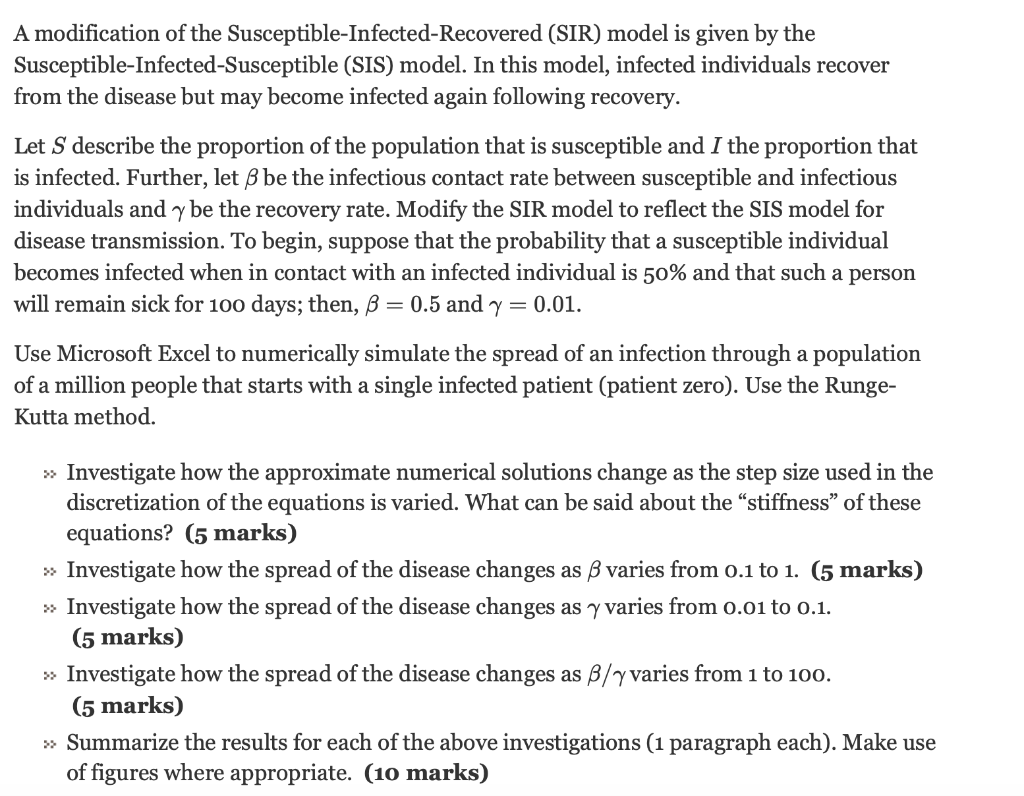

A modification of the Susceptible-Infected-Recovered (SIR) model is given by the Susceptible-Infected-Susceptible (SIS) model. In this model, infected individuals recover from the disease but may become infected again following recovery. Let S describe the proportion of the population that is susceptible and I the proportion that is infected. Further, let be the infectious contact rate between susceptible and infectious individuals and y be the recovery rate. Modify the SIR model to reflect the SIS model for disease transmission. To begin, suppose that the probability that a susceptible individual becomes infected when in contact with an infected individual is 50% and that such a person will remain sick for 100 days; then, B = 0.5 and v=0.01. Use Microsoft Excel to numerically simulate the spread of an infection through a population of a million people that starts with a single infected patient (patient zero). Use the Runge- Kutta method. >> Investigate how the approximate numerical solutions change as the step size used in the discretization of the equations is varied. What can be said about the stiffness of these equations? (5 marks) >> Investigate how the spread of the disease changes as varies from 0.1 to 1. (5 marks) >> Investigate how the spread of the disease changes as y varies from 0.01 to 0.1. (5 marks) >> Investigate how the spread of the disease changes as B/y varies from 1 to 100. (5 marks) >> Summarize the results for each of the above investigations (1 paragraph each). Make use of figures where appropriate. (10 marks) Using analytical methods, find the equilibrium points for the SIS model, and determine their stability. In particular, derive the conditions under which an epidemic will occur (i.e., the disease spreads throughout the majority of the population) and the conditions under which the disease does not reach epidemic proportions. (10 marks) Is it possible for periods of high disease prevalence to be followed by periods of low prevalence? Why or why not? (10 marks) A modification of the Susceptible-Infected-Recovered (SIR) model is given by the Susceptible-Infected-Susceptible (SIS) model. In this model, infected individuals recover from the disease but may become infected again following recovery. Let S describe the proportion of the population that is susceptible and I the proportion that is infected. Further, let be the infectious contact rate between susceptible and infectious individuals and y be the recovery rate. Modify the SIR model to reflect the SIS model for disease transmission. To begin, suppose that the probability that a susceptible individual becomes infected when in contact with an infected individual is 50% and that such a person will remain sick for 100 days; then, B = 0.5 and v=0.01. Use Microsoft Excel to numerically simulate the spread of an infection through a population of a million people that starts with a single infected patient (patient zero). Use the Runge- Kutta method. >> Investigate how the approximate numerical solutions change as the step size used in the discretization of the equations is varied. What can be said about the stiffness of these equations? (5 marks) >> Investigate how the spread of the disease changes as varies from 0.1 to 1. (5 marks) >> Investigate how the spread of the disease changes as y varies from 0.01 to 0.1. (5 marks) >> Investigate how the spread of the disease changes as B/y varies from 1 to 100. (5 marks) >> Summarize the results for each of the above investigations (1 paragraph each). Make use of figures where appropriate. (10 marks) Using analytical methods, find the equilibrium points for the SIS model, and determine their stability. In particular, derive the conditions under which an epidemic will occur (i.e., the disease spreads throughout the majority of the population) and the conditions under which the disease does not reach epidemic proportions. (10 marks) Is it possible for periods of high disease prevalence to be followed by periods of low prevalence? Why or why not? (10 marks)








